Ever-Burning Lamps of the
Ancients
Collection by Russo
Think about if you found a small burning lamp hidden deep in an ancient vault. This enigmatic lamp, which is in perfect state of preservation, has burned incessantly without fuel for the last two millennia.
What would you think about this astonishing discovery?
Is it a magical object? A work of the Gods? Perhaps some evil working? Proof of highly advanced technology in the past? Could this be that our ancestors discovered the secret of eternal light?

EVER-BURNING LAMPS
The world hears of the discovery of a "secret" Egyptian city (1935)(passim).
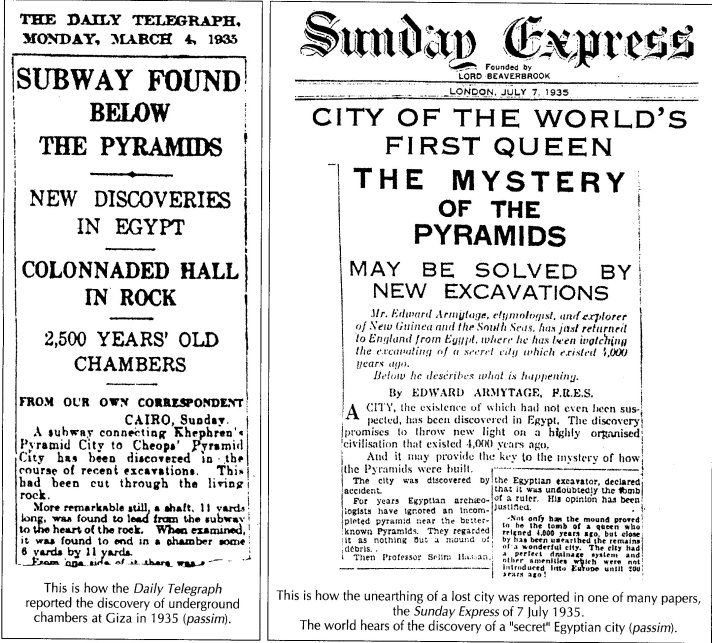
This is how the unearthing of a lost city was reported in one
of many papers, the Sunday Express of 7 July 1935.
SOURCE: NEXUS MAGAZINE via Galactic Server
Collection by Russo
Think about if you found a small burning lamp hidden deep in an ancient vault. This enigmatic lamp, which is in perfect state of preservation, has burned incessantly without fuel for the last two millennia.
What would you think about this astonishing discovery?
Is it a magical object? A work of the Gods? Perhaps some evil working? Proof of highly advanced technology in the past? Could this be that our ancestors discovered the secret of eternal light?

"Now the House of Solomon the
King was illuminated as by day, for in his wisdom he
had made shining pearls which were like unto the
sun, the moon and the stars in the roof of his
house. " (From: "The Queen of Sheba and Her Only Son
Menyelek")
EVER-BURNING LAMPS
Quote
In spite of amazing discoveries, the stark truth is that the early history of Egypt remains largely unknown and therefore unmapped territory. It is not possible, then, to say precisely how miles of underground passageways and chambers beneath the Giza Plateau were lit, but one thing is for sure: unless the ancients could see in the dark, the vast subterranean areas were somehow illuminated.
The same question is addressed of the interior of the Great Pyramid, and Egyptologists have agreed that flaming torches were not used, for ceilings had not been blackened with residual smoke.
From what is currently known about subsurface passageways under the Pyramid Plateau, it is possible to determine that there are at least three miles of passageways 10 to 12 storeys below ground level. Both the Book of the Dead and the Pyramid Texts make striking references to "The Light-makers", and that extraordinary description may have referred to a body of people responsible for lighting the subterranean areas of their complexes.
Iamblichus recorded a fascinating account that was found on a very ancient Egyptian papyrus held in a mosque in Cairo. It was part of a 100 BC story by an unknown author about a group of people who gained entry to underground chambers around Giza
for exploratory purposes. They described their experience:
We came to a chamber. When we entered, it became automatically illuminated by light from a tube being the height of one man's hand [approx. 6 inches or 15.24 cm] and thin, standing vertically in the corner. As we approached the tube, it shone brighter. . .the slaves were scared and ran away in the direction from which we had come! When I touched it, it went out. We made every effort to get the tube to glow again,
but it would no longer provide light. In some chambers the light tubes worked and in others they did not.
We broke open one of the tubes and it bled beads of silver coloured liquid that ran fastly around the floor until they disappeared between the cracks (mercury?)
As time went on, the light tubes gradually began to fail and the priests removed them and stored them in an underground vault they specially built southeast of the plateau. It was their belief that the light tubes were created by their beloved Imhotep, who would some day return to make them work once again.
It was common practice among early Egyptians to seal lighted lamps in the sepulchres of their dead as offerings to their god or for the deceased to find their way to the "other side". Among the tombs near Memphis (and in the Brahmin temples of India), lights were found operating in sealed chambers and vessels, but sudden exposure to air extinguished them or caused their fuel to evaporate.(6)
Greeks and Romans later followed the custom, and the tradition became generally established-not only that of actual burning lamps, but miniature reproductions made in terracotta were buried with the dead. Some lamps were enclosed in circular vessels for protection, and instances are recorded where the original oil was found perfectly preserved in them after more than 2,000 years. There is ample proof from eyewitnesses that lamps were burning when the sepulchres were sealed, and it was declared by later bystanders that they were still burning when the vaults were opened hundreds of years later.
The possibility of preparing a fuel that would renew itself as rapidly as it was consumed was a source of considerable controversy among mediaeval authors, and numerous documents exist outlining their arguments. After due consideration of evidence at hand, it seemed well within the range of possibility that ancient Egyptian priest-chemists manufactured lamps that burned if not indefinitely then at least for considerable periods of time.
Numerous authorities have written on the subject of everburning lamps, with W. Wynn Westcott estimating that the number of writers who have given the subject consideration as more than 150 and H. P. Blavatsky as 173. While conclusions reached by different authors are at a variance, a majority admitted the existence of the phenomenal lamps. Only a few maintained that the lamps would burn forever, but many were willing to concede that they might remain alight for several centuries without replenishment of fuel.
It was generally believed that the wicks of those perpetual lamps were made of braided or woven asbestos, called by early alchemists "salamander's wool". The fuel appeared to have been one of the products of alchemical research, possibly produced in the temple on Mt Sinai. Several formulae for making fuel for the lamps were preserved, and in H. P. Blavatsky's profound work, Isis Unveiled, the author reprinted two complicated formulae from earlier authors of a fuel that "when made and lighted, will burn with a perpetual flame and you may set this lamp in any place where you please ".
Some believe the fabled perpetual lamps of temples to be cunning mechanical contrivances, and some quite humorous explanations have been extended.
In Egypt, rich underground deposits of asphalt and petroleum exist, and some would have it that priests connected asbestos wicks by a secret duct to an oil deposit, which in turn connected to one or more lamps. Others thought that the belief that lamps burned indefinitely in tombs was the result of the fact that in some cases fumes resembling smoke poured forth from the entrances of newly opened vaults. Parties going in later, and discovering lamps scattered about the floor, assumed that they were the source of the fumes. There were some well-documented stories concerning the discovery of ever-burning lamps not only in Egypt but also in other parts of the world.
De Montfaucon de Villars gave this fascinating account of the opening of the vault of Rosicrucian Christian Rosenkreuz. When the Brethren entered the tomb of their illustrious founder 120 years after his death, they found a perpetual lamp brightly shining in a suspended manner from the ceiling. "There was a statue in armour [a robot] which destroyed the source of light when the chamber was opened."7 That is strangely similar to the accounts of Arab historians who claimed that automatons guarded galleries under the Great Pyramid.
A 17th-century account recorded another story about a robot. In central England, a curious tomb was found containing an automaton that moved when an intruder stepped upon certain stones in the floor of the vault. At that time, the Rosicrucian controversy was at its height, so it was decided that the tomb was that of a Rosicrucian initiate. A countryman discovered the tomb entered and found the interior brilliantly lit by a lamp hanging from the ceiling. As he walked toward the light, his weight depressed the floor stones and, at once, a seated figure in heavy armour began to move. Mechanically it rose to its feet and struck the lamp with an iron baton, destroying it and thus effectively preventing the discovery of the secret substance that maintained the flame. How long the lamp had burned was unknown, but the report said that it had been for a considerable number of years.
The world hears of the discovery of a "secret" Egyptian city (1935)(passim).

This is how the unearthing of a lost city was reported in one
of many papers, the Sunday Express of 7 July 1935.
SOURCE: NEXUS MAGAZINE via Galactic Server
YOUTUBE LINK
From UFOTV
Beneath the pyramids of Egypt lies a lost underworld of catacombs, hewn chambers and cave tunnels that have remained unexplored for hundreds of years. They are alluded to in ancient texts and Arab legends, but have been left unexplored until today. They have now been rediscovered and investigated for the first time. What exactly does this subterranean realm tell us about the pyramids, their relationship to the stars and the mythical origins of Egyptian civilization? Discover for yourself as we explore the "Lost Caves of Giza."
Re: The Caves under Giza
We covered that back at ATS when Collins first made the announcement. We have the files here;
They were announced during our ISIS thread Page 16 The finder of the caves, Andrew Collins, even posted at ATS. We actually wrote the guys who did the ground penetrating adar Those files are posted in the link above. Zahi Hawass denied it but we caught him red handed... exiting those caves.
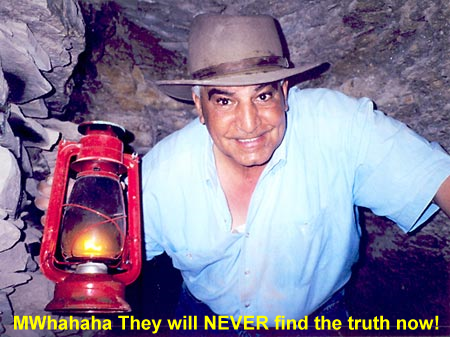
Beneath the pyramids of Egypt lies a lost underworld of catacombs, hewn chambers and cave tunnels that have remained unexplored for hundreds of years. They are alluded to in ancient texts and Arab legends, but have been left unexplored until today. They have now been rediscovered and investigated for the first time. What exactly does this subterranean realm tell us about the pyramids, their relationship to the stars and the mythical origins of Egyptian civilization? Discover for yourself as we explore the "Lost Caves of Giza."
Re: The Caves under Giza
We covered that back at ATS when Collins first made the announcement. We have the files here;
They were announced during our ISIS thread Page 16 The finder of the caves, Andrew Collins, even posted at ATS. We actually wrote the guys who did the ground penetrating adar Those files are posted in the link above. Zahi Hawass denied it but we caught him red handed... exiting those caves.

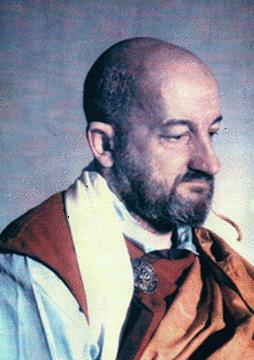
Dr Tuesday Lobsang Rampa
In the book THE CAVE OF THE ANCIENTS - the Tibetan Lobsang Rampa talks about these kind of lamps: short extract:
" ...One sequence of pictures showed a group of thoughtful men planning what they termed a "Time Capsule" (what we called "The Cave of the Ancients"), wherein they could store for later generations working models of their machines and a complete, pictorial record of their culture and lack of it. Immense machines excavated the living rock. Hordes of men installed the models and the machines. We saw the cold light spheres hoisted in place, inert radio-active substances giving off light for millions of years. Inert in that it could not harm humans, active in that the light would continue almost until the end of Time itself.
We found that we could understand the language, then the explanation was shown, that we were obtaining the "speech" telepathically. Chambers such as this, or "Time Capsules", were concealed beneath the sands of Egypt, beneath a pyramid in South America, and at a certain spot in Siberia. Each place was marked by the symbol of the times; the Sphinx. We saw the great statues of the Sphinx, which did not originate in Egypt, and we received an explanation of its form. Man and animals talked and worked together in those far-off days. The cat was the most perfect animal for power and intelligence. Man himself is an animal, so the Ancients made a figure of a large cat body to indicate power and endurance, and upon the body they put the breasts and head of a woman. The head was to indicate human intelligence and reason, while the breasts indicated that Man and Animal could draw spiritual and mental nourishment each from the other. That Symbol was then as common as is Statues of Buddha, or the Star of David, or the Crucifix at the present day.
We saw oceans with great floating cities, which moved....
Dr T Lobsang Rampa Books - Pegasus
10 Unsolved Mysteries
From Ancient Times
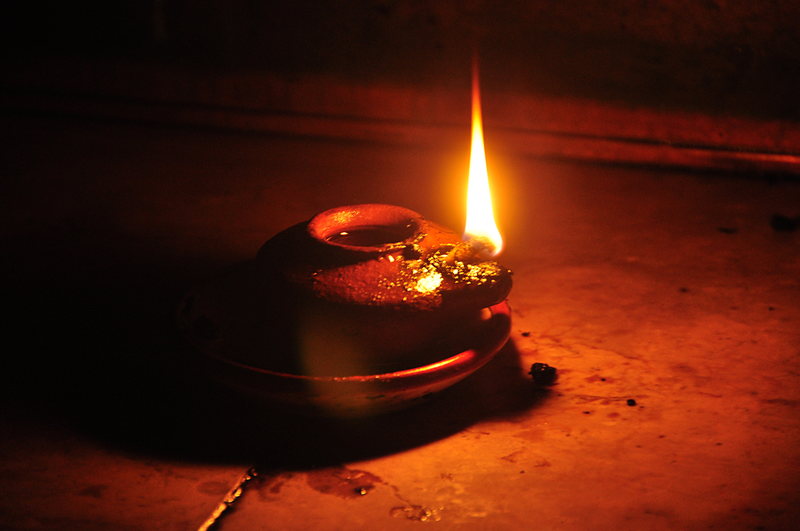

Quote
Lamps that kept on burning without using any fuel were discovered all over the world during the Middle Ages. These lamps were sealed into tombs, supposedly to ensure the deceased had light to guide them on their way to the afterlife.
Some of these tombs were opened years later, and the lamps were still burning.Superstitious types became terrified of this phenomenon, destroying any ever-burning lamp they came across. People accused pagan priests of trickery. Others simply refused to believe that a lamp could burn for an indefinite period of time. The vast majority claimed that the Devil was to blame.
Speculation was also rife that Hebrew communities had discovered and preserved what today is known as electricity. According to the legend, a French rabbi named Jechiele possessed a lamp that could light up by itself, with no fuel or wick. Jechiele, according to this tale, invented a special button that would discharge an electric current to his metal door knocker.
If someone touched the door knocker at the same time the rabbi touched the nail, the person would receive a shock and double over.Even with electricity being a common thing nowadays, all who have tried to replicate the ever-burning lamps have failed. Therefore the question remains: How were these lamps able to keep burning for hundreds of years without fuel?
SOURCE: 10 Unsolved Mysteries
The Initiates of the Flame
1922. Hall, the American
philosopher, in over a period of 20 years of dynamic
public activity, has steadfastly sought recognition
of the belief that world civilization can only be
perfected when human beings meet on a common ground
of intelligence, cooperation and worthy purpose. The
Initiates of the Flame is a reverent and inspired
tribute to the ancient wisdom teachings. Though
mystical in spirit, this work explains many keys to
esoteric philosophy. See other titles by this author
available from Kessinger Publishing.
"Few realize that even at the present stage of civilization in this world, there are souls who, like the priests of the ancient temples, walk the earth and watch and guard the sacred fires that burn upon the altar of humanity.
Purified ones they are, who have renounced the life of this sphere in order to guard and protect the Flame, that spiritual principle in man, now hidden beneath the ruins of his fallen temple.
But the Flame did not die. Like the spirit of which it is the essence, it cannot die, because it is life, and life cannot cease to be. In some wilderness of land or sea it rested once again, and there rose a mighty nation around that flame. So history goes on through the ages.
Let us find this Flame and also serve it, realizing that it is in all created things, that all are one because all are part of that eternal Flame, the fire of spirit, the life and power of the universe."Excerpted from "The Initiates of the Flame"
by Manly P. Hall
[1928, copyright not renewed]
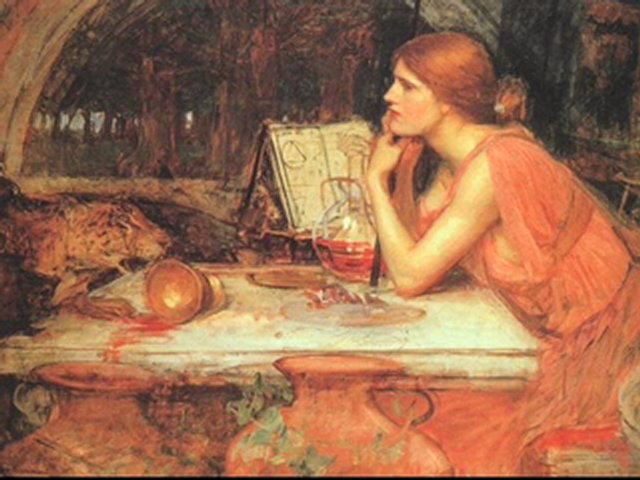
Credit: John William Waterhouse
"Ever-burning lamps have been
discovered in all parts of the world. Not only the
Mediterranean countries but also India, Tibet,
China, and South America have contributed records of
lights which burned continuously without fuel."
"In a tomb on the Appian Way
which was opened during the papacy of Paul III was
found a burning lamp which had remained alight in a
hermetically sealed vault for nearly 1,600 years.
According to an account written by a contemporary, a
body--that of a young and beautiful girl with long
golden hair--was found floating in an unknown
transparent liquid and as well preserved as though
death had occurred but a few hours before."
"Some of the lamps were
enclosed in circular vessels for protection; and
instances have been recorded in which the original
oil was found in them, in a perfect state of
preservation, after more than 2,000 years. [...]
After due consideration of the evidence at hand, it
seems well within the range of possibility that the
ancient priest-chemists did manufacture lamps that
burned, if not indefinitely, at least for
considerable periods of time. [...] Only a few
maintained that the lamps would burn forever, but
many were willing to concede that they might remain
alight for several centuries without replenishment
of the fuel."
Manly P. Hall / The Secret Teachings of all Ages
Source: Sacred Texts
Quote
Hargrave Jennings presents a fascinating look at and interpretation of the philosophy and nature of the Rosicrucian Order in this classic work. It is an indispensable work for any student of the Rosicrucians or the Mysteries Schools.
"This book, which now leaves our hands, concentrates in a small compass the results of very considerable labour, and the diligent study of very many books in languages living and dead. It purports to be a history (for the first time treated seriously in English) of the famous Order of the 'Rose-Cross', or of the 'Rosicrucians'. No student of the occult philosophy need, however, fear that we shall not most carefully keep guard--standing sentry (so to speak) not only over this, which is, by far, the pre-eminent, but also over those other recondite systems which are connected with the illustrious Rosicrucians." Includes a clickable Table of Contents.
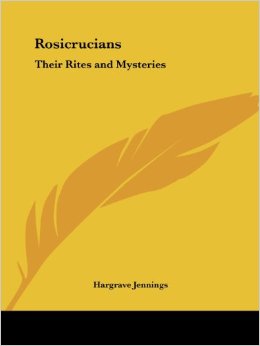
The Rosicrucians: Their Rites and Mysteries
Amazon Books




The Rosicrucians: Their Rites and Mysteries - [PDF][Archived]


Webpages © 2001-2015 Blue Knight Productions |




